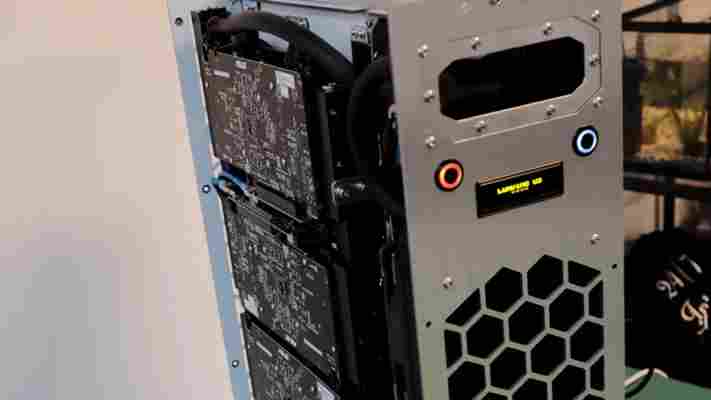Someone paid $170,000 for the most expensive CryptoKitty ever
Blockchain-based game CryptoKitties has seen the highest trade volume since February over the past 24 hours, and it has only one cute little kitten to thank for it.

Someone purchased Dragon , a CryptoKitty, for 600 ETH ($170,000 approximately) on Tuesday, making her the most expensive kitty to be ever traded in the history of the game.
Dragon broke the record of Founder Cat #18 , which sold for 253 ETH ($110,000 at the time of sale) in December last year.
On primary inspection, Dragon looks like your average CryptoKitty. She’s got average looks and average attributes (called “Cattributes”). Remarkably, she’s a ninth generation kitty – earlier generations tend to be more expensive . Overall, she doesn’t fit the stereotype of what an expensive CryptoKitty should look like.


This is how Dragon describes herself on the CryptoKitties website:
With her looks out of the window, there can be only speculations on what makes her so precious. Perhaps the buyer and seller wanted to make a transaction anyway, so they traded this CryptoKitty? Some speculate it could be money laundering. Or maybe the buyer was delighted she bit Rebecca Black (anyone who has endured Friday would be!). Likely, we’ll never know.
Regardless, Dragon is good omen for CryptoKitties. The Ethereum-based decentralized app (DApp) has seen very little engagement since the beginning of this year. Total transactions on the app dropped by 98.4 percent between December and January and have remained low ever since. Now, Dragon has brought a spike in both the trading volume and average kitty price.
The total ETH trading volume on CryptoKitties on Tuesday (622 ETH) was higher than the previous week combined.
Dragon also rode the average daily kitty price to the highest in the history of the game at 1.17 ETH, in comparison to the previous 0.4 ETH on December 4, 2017.
Dragon’s astonishing achievement is coming at a time when the game is also about to see the birth of its one millionth CryptoKitty.
We used a cryptocurrency miner as a heater this winter and it really worked
Surfing through the web back in October, I stumbled upon an odd but genuinely fascinating contraption : a Russian cryptocurrency miner that leverages the heat it generates from stacking Ethereum to keep your room warm.

Shortly after I wrote about this unusual device, Comino – the Russian-based startup behind this invention – reached out to us and kindly offered to ship one of its miners for us to test this winter. We gladly took them up on their offer, and a couple of weeks later, the Comino was already installed at our cozy office in Amsterdam.
After running the crypto-heater for a little over a month now, we are finally ready to share our experience with the device. But before we get to the actual performance, let’s get the technicalities out of the way.
Determined to deliver the device in optimal condition, Comino co-founder Evgeny Vlasov flew in directly from Moscow to Amsterdam, along with his business partner Anatoliy Knyazev (not to be mistaken with the eponymous DC Comics villain KGBeast ).
The duo swiftly set up the crypto-heater and proceeded to give us a run-down on the technology that powers the machine.
Vlasov and Knyazev first came with the idea for Comino after they spotted an opportunity to bridge the technological gap in the bludgeoning cryptocurrency market by bringing a mining solution that even crypto-rookies can put to use.
As such, the Comino is among the first miners specifically aimed at regular consumers – and not strictly hardcore crypto-enthusiasts.
“It is an overused statement these days, but we want to be the Apple of crypto-miners,” Knyazev told TNW. “We want to make a product that is easy for everyone to use. Ideally, you won’t even need to read through the documentation, you just plug it in and it starts working.”
Having said that, Comino, which runs a customized version of Ubuntu, can easily be modified for tasks other than mining. Indeed, Vlasov told us Comino often gets enqiuiries from researchers, involved with high-intensity computing tasks, who are interested in re-purposing the machine for other uses.
The reason for that is not strictly the components housed inside its metallic case, but its efficient and sturdy build quality. Vlasov and Knyazev too are first to admit that the real value in Comino – as far as hardware goes at least – is in the proprietary components that connect all the GPUs packed inside the crypto-miner.
As Vlasov explains, unlike home-made miners, which tend to be rather bulky in size and often make very loud noises, the Comino was designed to be much more discrete and accommodating. It was also equipped with proprietary water-cooling system that Vlasov and Knyazev claim will keep the machine alive for years – a lifespan much longer than that of most home-made mining rigs.
Comino’s website claims a maximum noise level of around 30 decibels, and while I’m no noise expert, the review unit we tested was pretty silent – much quieter than an actual fan-heater.
In fact, the noise is so low that at one point Knyazev worryingly misidentified the sound from the little fish aquarium we have in our office with that of the Comino. Indeed, the crypto-heater is less noisy than an aquarium.
Here are a couple videos that will give you a better idea about the cacophony home-built miners cause:
In addition to its proprietary water-cooling system, the device also comes with a slew of custom-made components – like cables, connectors and risers – to ensure the longevity of the device.
The reason Comino opted to produce their own risers was because industry alternatives couldn’t offer the same resistance to high-intensity signals and waves that mining rigs have to deal with. Vlasov estimates that the compendium of little touches like these ought to keep the miner up-and-running for at least five to 10 years.
As far as the rest of the innards go, the Comino N1 (the model we had a chance to test) boasts eight ASUS P106-100 6G graphic cards mounted on an ASUS PRIME Z270-A Motherboard, as well as 3 NOCTUA NF-A14 PPC-2000 PWM fans, a customized Black Ice NEMESIS GTX420 radiator and 2 Chieftech PROTON BDF-750C 750W power supply units.
All of this oomph amounts to about 1kW of power consumption per hour. Make sure to check your local electricity rates to get an idea of how much that will add up to your energy bills.
The contraption stands 63.5cm tall, with a length of 45.9cm and a width of17.5cm, which means you could easily fit it in an idle corner of your room and forget about it, while it does the mining for you. And this is precisely what we did.
Once we installed the mining rig in our office, which practically included connecting the crypto-heater to the internet via the web-based dashboard system developed by Comino, it automatically created a wallet and began mining Ethereum. As easy as this.
Of course, if you already have a wallet, you still have the option to connect it to the dashboard. You can also connect any other mining rig to the Comino dashboard, in case you want to follow all of your mining efforts in one place.
Among other things, the online dashboard shows a number of statistics the Comino developers had programmed to monitor, including the current and average hashrate at which the miner is solving cryptographic puzzles, the current and average temperature at which it operates, as well as the unpaid balance of Ethereum you’ve accumulated. It also shows stats for the temperature of each separate GPU.
Since installing the miner on November 16, it has so far transferred a total of little over 1.2 ETH to my designated wallet – this equals to roughly 1 ETH per month. At the time of writing, my mining returns amount to about $814, according to CoinGecko .
The way the system is set-up, the miner will transfer the Ethereum to a wallet of your choice anytime it has mined at least 0.2 ETH.
As you can observe in the screenshots below, the Comino N1 maintains an average hashrate of about 200 MH/s, and an average temperature of approximately 60C (±140F) degrees .
While some of this data is visible on the device’s built-in LCD indicator, chances are you will find yourself engaging with the online dashboard much more often than with the actual miner – and this is actually how Vlasov and Knyazev imagine things.
Other than a one-off exception to reboot the miner, following a glitch in the LCD display (which had no effect on the actual mining), I hardly ever had to interact with the machine; and this is a good thing, especially for someone who wants to stack on crypto without having to worry about technical issues.
Throughout this one-month trial, the only issue I experienced with the miner was that – for some reason – its ambient temperature sensor inaccurately picked up the temperature of the GPUs inside (which had just taken a break from mining); this prevented the device from booting up again, until it cooled down a little.
But other than that, it ran as smooth as butter. After reporting this minor malfunction to Vlasov, he told us their team is looking into implementing a solution that will allow the machine to turn on, but will only let it mine once it has cooled down to a more suitable temperature.
At $5,000 a piece (currently discounted down to $4,500), the Comino miner is certainly not cheap, but if you’re looking for an easy way to get started with mining cryptocurrency, it definitely does the job.
In all fairness, you can probably build a cheaper mining rig, but Vlasov and Knyazev are skeptical about the lasting endurance of recreational mining rigs. Of course, if neither of these options appeal to you, you can always fit your own crypto-miner in the trunk of your Tesla – like this guy set out to do .
And in case you were wondering about how reliable the Comino was as a heater: it certainly kept the temperature high enough to save some energy on heating bills, but not enough to make you turn on the air conditioner. Which is exactly what you want from a machine that was built to bank on crypto.
Removing Bitcoin payments from Steam is a smart move by Valve
It was a huge boon to the cryptocurrency community when Valve began accepting payments in Bitcoin on its game distribution platform Steam over a year ago. But this is all coming to an end – at least for the time being.

In a blog post from yesterday, the company announced it will no longer support the popular cryptocurrency as a payment method “ due to [its] high fees and volatility” in price. While transaction rates used to be as low as 20¢ last year, Valve says the fees topped out at $20 last week.
“These fees result in unreasonably high costs for purchasing games when paying with Bitcoin. The high transaction fees cause even greater problems when the value of Bitcoin itself drops dramatically,” the post read. “Unfortunately, Valve has no control over the amount of the fee.”
This is clearly a problem for both the company and its users.
“ Historically, the value of Bitcoin has been volatile, but the degree of volatility has become extreme in the last few months, losing as much as 25 [percent] in value over a period of days,” Valve continued. “This creates a problem for customers trying to purchase games with Bitcoin.”
The issue is that the Bitcoin price of a game can experience significant changes in merely a matter of minutes. As you can imagine, this can be particularly annoying for users that transfer a certain amount of the cryptocurrency, only to discover that this amount is no longer sufficient because its value has dropped.
“ The normal resolution for this is to either refund the original payment to the user, or ask the user to transfer additional funds to cover the remaining balance,” Valve remarked on this conundrum. “In both these cases, the user is hit with the Bitcoin network transaction fee again.”
While the move might strike a nerve with some hardcore crypto-enthusiasts, it is difficult to blame Valve for its pragmatism given that the issue directly affects its customers.
True, the price of Bitcoin has generally followed an upward curve over the past few months, but that on its own is not a reason good enough for Valve to keep the cryptocurrency. The aim was always to offer users a reliable payment method at lower than standard fees.
Now that this is no longer the case, the integration is more of a nuisance than a feature.
Then, of course, there is the whole issue with Bitcoin’s sluggish transaction times and its congested blockchain network. At the time of writing, there are over 135,000 unprocessed transactions . So if you were to place a transaction now, chances are it will take a while before it goes through.
Having said this, it’s still sad to see a major platform drop support for Bitcoin. But perhaps things will change once there is a better scaling solution in sight.

Leave a Comment